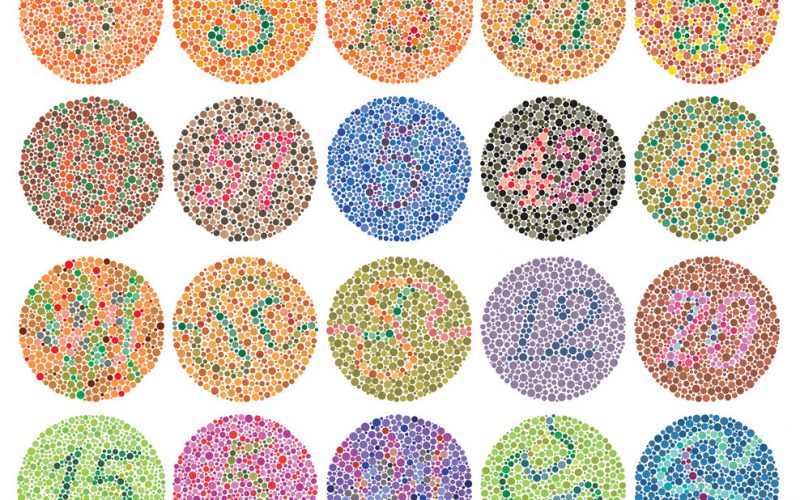Yellow-orange sunsets, clear blue skies, freshly cut green lawns, and the array of colorful fall leaves—beautiful sights, right?
It would be wonderful if everyone could experience the rainbows offered by life and nature, but that’s unfortunately not the case. Many people suffer from color blindness, which means they perceive a narrower color spectrum compared to those with “normal” color vision.
They may be unable to see how bright a color is, distinguish between shades of color, or see the differences between colors. Although there is no cure for color blindness, there are color blind glasses, designed to help those who are colorblind to see colors more accurately.
What Are Color Blindness Glasses?
Aside from inherited color blindness types, like red-green color blindness (the most common form of color blindness) and blue-yellow color blindness, there are other causes of color blindness. These include eye diseases (i.e. glaucoma), eye or brain injuries, nervous system, and brain diseases (i.e. MS), as well as some medications.
While there are no cures for the inherited types, there are coping strategies, visual aids, apps, and other technologies that may help. Additionally, there are special contacts and glasses for color blindness. Depending on the type of color blindness a person has and the extent, specially formulated colorblind glasses may improve the contrast between colors and enhance vibrancy. They may also boost color depth, detail perception, and differentiation.
Remember, results vary. It is suggested to consult a vision therapy physician or ophthalmologist to discuss options and to determine a care plan specific to your needs.
A Little History
John Dalton, a chemist and scientist, was said to be the first to take an academic interest in the subject, as he and his brother were both colorblind. Dalton’s interests led him to conduct extensive tests, in addition to writing and publishing the first scientific paper on color blindness, during the late 1700s. It was entitled, “Extraordinary facts relating to the vision of colours”.
His studies have contributed to the modern day innovations in color vision technology and the invention of glasses for the colorblind, such as the EnChroma lenses invented in 2002. EnChroma lens technology offers a simplified differentiation of colors and an increase in the contrast of red and green colors.
How Do They Work?
The color blind glasses developed by EnChroma are wildly popular, which means countless people pose the question: “how do enchroma glasses work?” We all see color differently, even if we have never been diagnosed with color blindness. For those suffering from color vision deficiencies, there is a major difference in the reaction to light and how the brain interprets it.
Within the retina, there are three color-detecting cone cells (red, blue, green). When one or more cones are not working, absent, or detects abnormal color, genetic color blindness can occur. Those who find it challenging to detect green or red light are experiencing overlapping between the light wavelengths used by our brain to determine green or red color, which confuses the brain.
EnChroma’s patented lens technology utilizes a patented light filter technique, which filters out overlapping wavelengths of light (such as red and green) at precise points where the brain typically gets confused and has difficulty distinguishing between colors. Color blind corrective glasses absorb and filter out some of these wavelengths, which hinders the problem of overlapping and allows the brain to better distinguish between the colors.
The Results
The verdict is still out regarding the impact of corrective lenses for color blindness, as there are a wide range of results and caveats, such as each person’s color vision deficiencies being unique to them.
Some people, upon wearing color blind glasses for the first time, experience immediate results, seeing drastic differences in their color perception. Others experience very limited results, or may see no difference at all. There are two things to keep in mind when speaking about EnChroma glasses or any other manufacturer of glasses to correct color blindness: the glasses may not work for those who are severely colorblind, and the glasses are not a cure.
Regarding results, we suggest taking some time to read through clinical studies and recent research, but do not let it sway you too much. In addition, to get the best advice and guidance for your specific vision needs, consult a vision therapy physician or ophthalmologist.
About Color Blindness
If we go by John Dalton’s published work in the late 1700s, the subject of color blindness (or color vision deficiency) has been around for 200+ years. That said, color blindness is very common, affecting more than three million per year. Additionally, the most common types of color blindness are inherited genetically, like red-green color blindness.
Surprisingly, more men are affected by color blindness, as opposed to women. Reportedly, 1 in 12 men and 1 in 200 women are color blind. As mentioned before, there is no cure for color blindness, through innovation and advancements in research and science have birthed more efficient tests, more precise diagnoses, and lens technology to help those coping with color vision deficiencies.
Felix Gray
Whether you’re dealing with color blindness, seeking additional information on color vision deficiencies, or asking yourself, “how do colorblind glasses work?”, we wanted to offer our audience an insightful and expert view of the subject.
When it comes to vision, we at Felix Gray make it our business to know all the details about hot button vision topics that our customers may be wondering about. That’s why, even though we specialize in Blue Light blocking glasses and don’t actually sell color blind glasses, we hope we were able to shed some light on the issue and help you see it a bit clearer.
Now, if you happen to need a pair of Blue Light blocking glasses, we’d be happy to direct you to our eyeglasses page.
